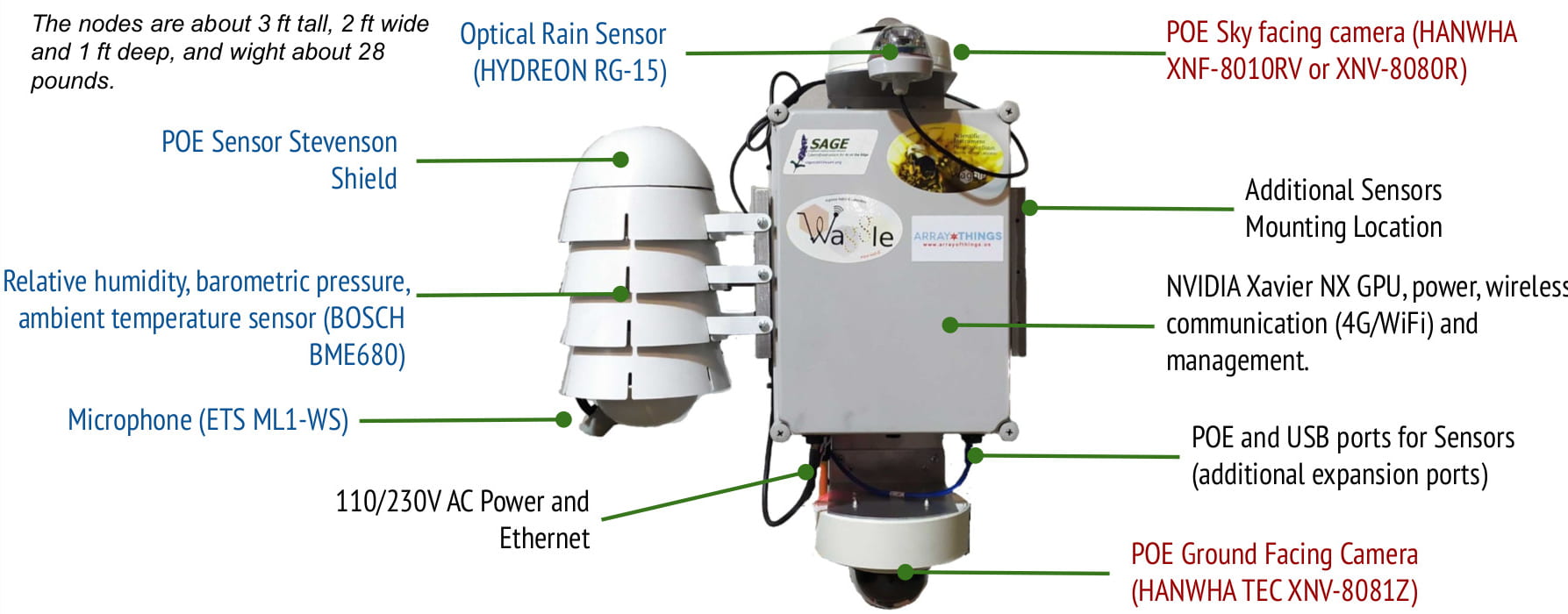Sage Continuum
Cyberinfrastructure for AI at the EdgeCyberinfrastructure is essential to our research platform. To accelerate our growth in this important area, we are partnering with Sage.
In 2019, the National Science Foundation awarded a $9 million grant to a team led by Northwestern University to launch Sage. The goal was to build a continent-spanning network of smart sensors to improve the flow of information between scientists and the natural world. These small computers, called Wild Sage Nodes, can be deployed in the field to collect data about the environment for research. They include rain gauges, cameras, microphones, and sensors that measure barometric pressure, humidity, and ambient temperature.

These sensors can generate such large volumes of data that fast and efficient analysis is best performed by an embedded computer connected directly to the sensor. Edge computing rapidly analyzes the complete volume of sensor data to detect emerging issues like wildfires and study long-term trends like climate change.
Sage applies machine learning algorithms to smart sensor data and builds reusable software that can run programs within the embedded computer and transmit results to central computer servers. This enables researchers to understand and respond to data almost instantly. The software components are open source and provide the architecture for scientists from a wide range of fields to build their own intelligent sensor networks. Distributed, intelligent sensor networks that can collect and analyze data on-site are an essential tool for scientists seeking to understand the impacts of natural disasters and climate change on ecosystems and infrastructure.
The Oregon Hazards Lab is integrating Sage technology into our alerting and monitoring network as well. We deployed Wild Sage Nodes at three seismic monitoring stations and four wildfire camera sites in 2023. By linking small, powerful computers directly to our monitoring sensors and high-resolution cameras, Sage gives us and our partners a new tool to understand our changing planet.
Learning More about Sage
What is the Sage Project being used for?
New uses emerge frequently as domain and computer scientists develop new applications. Some of the current applications include:
- Wildfire science
- Nowcasting weather
- Monitoring biodiversity
- Water level detection
- Lightning science state estimation
- Characterizing clouds
- Snowflake classification
Who are common users of Sage technology?
The most common users have included:
- Domain scientists interested in developing edge AI applications
- Users interested in sensor and application-produced datasets
- Cyberinfrastructure researchers interested in platform research
- Domain scientists interested in adding new sensors and deploying nodes to answer specific science questions
Where else are Sage sensor nodes being deployed?
Sage and its partners are deploying senor nodes that support machine learning frameworks in environmental testbeds in California, Colorado, Kansas, and Oregon, as well as in urban environments in Illinois and Texas. Outside of the United Sates, partners are also deploying testbeds in Australia, Japan, Taiwan, and the United Kingdom. These locations provide scientists with even more data for analysis.
What are the benefits of edge computing?
Many of today’s environmental monitoring systems struggle to process the immense volume of data that sensors can provide. Some systems resort to saving the data on hard drives that are retrieved from sensors a few times a year. Other systems only collect a small portion of the valuable data and upload it to a cloud server through a slow wireless connection. With Sage, advanced machine learning algorithms is moved to “the edge.” Edge computing streamlines data flowing from devices by analyzing data at the site where it is collected.
